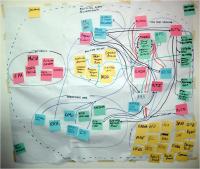
There are a lot of approaches, methodologies, toolkits, assessment instruments and questionnaires available for use by staff and managers in organisations, or for use by consultants. Quantity is not the problem. The problem is how to find your way to something "good enough" that serves your purpose, or the purposes of those you work with.
No single set of tools and approaches to CD can claim superiority. There are, however, some basic principles and good practices to follow. Europeaid has developed tools and material reflecting this emerging consensus and state of the art thinking in this area:
- The EC Guidelines on "Making Technical Cooperation More Effective", 2009, notably section 3.3 presenting recommendations about the approach, the principles and key questions to direct work.
- The EC "Toolkit for Capacity Development" , 2009
- The EC Reference Documents on "Institutional Assessment and Capacity Development", 2005
Remember that the "how" is as important as the "what". Paying attention to the process of capacity assessment can influence results as much as the details of the assessment areas. To start on the right foot, self assessments are recommended and partner countries, or the concerned organisations, should always lead or coordinate the exercise.
Click here to see recommended links and tools. Suggestions for additions and updates are, of course, most welcome. We aim to keep this resource guide alive as a path through the jungle of material, recognising that there are many such paths...!




(2)
Log in with your EU Login account to post or comment on the platform.
Hi, you can now find all (well, I am still uploading but they will be soon all there) the methodological publications of the EuropeAid Thematic Units (the ones of the Tools and Methods Series) in the Public group with the same name (means Tools and Methods Series).
http://capacity4dev.ec.europa.eu/t-and-m-series/
They are also in several specific groups but we thought it might be helpful to have them all in one place.
2012 will be a very good year as most of the "older" publications are being redrafted and compiled. Stay informed! Coralie
Having looked through several of the toolkits offered at the link I have the impression that they are trying to capture every possible circumstance. That makes them appear over complicated. The critical factor is acquiring the information about the context of a project, knowing what the drivers are and what 'drives' the key actors. Then and only then can a plan be made to design, implement and monitor a project to its desired outcome.
It seems to me that two things are needed. A common knowledge creation process and a simple but powerful planning tool which can visualise and use the knowledge gained.
We have such a tool (a web based software application) and would like it tested in a complex environment. We use it internally inside our company but it almost certainly has a universal application to complex and dynamic operating environments.
Please make contact if you are interested and I will tell you more. In essence, I think our tool enables all the policy papers and toolkits mentioned and supports collaboration.